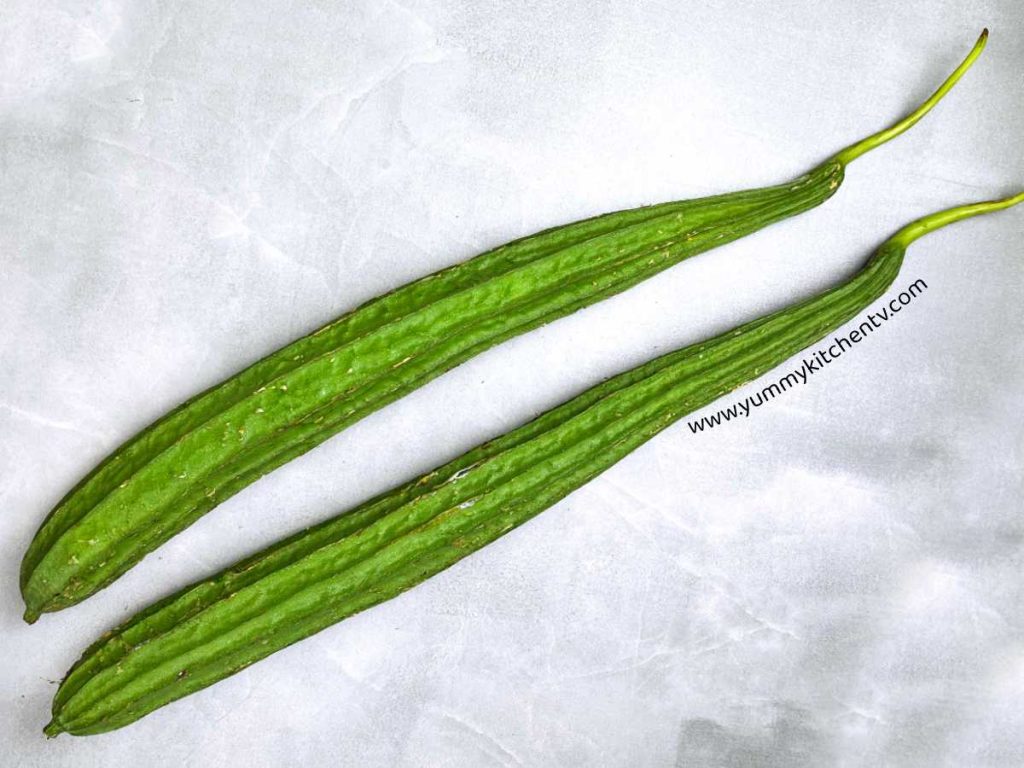The Sponge gourd, or called the scientific name ‘Luffa aegyptiaca’, is a herbaceous tropical climbing vine fruit, growing cylindrical in length, with a light lime green or dark green skin that is often consumed as a vegetable.
A short Introduction
The sponge gourd (pronounced ‘spuhnj-gord’) is called many names such as ‘Loofah’ or ‘Luffa’ gourd, and ‘Dishcloth Gourd’, this is because this fruit is sometimes grown and dried into a sponge. A sponge used for washing utensils like cutlery, dishware, and for bathing.
A fruit that grows all year round, and thrives in humid climates. While there is no finality of where it originated from, it is known to be native to Asia, especially bountiful in countries such as Philippines, India, and Myanmar. This plant develops in between the months of February to May, and in June to September where they are cultivated in irrigated farms. These are part of the cucumber family, planted early in the season, these grow from vigorous growing vines that grows to a length of more than 30 feet supported by a pole, it bears a long cylindrical shaped fruit, having a smooth light lime or dark green outer skin, a white colored fibrous inner flesh similar to a zucchini or bitter melon, has numerous small white seeds scattered in the middle, while these are edible when the gourd is still young and fresh, there are a small amount of people who remove these before cooking. The taste of the loofah gourd slightly resembles the taste of zucchini as well, being mild and can easily absorb the sauces or flavors of the seasonings added. This fruit can grow about 2 feet in height, harvested once it’s ripened, eaten not only for its refreshing taste but for its many benefits, like fiber, Vitamin A and C, known to be great for diabetes, skin diseases, jaundice, and many more.
Difference between Ridge gourd and Sponge gourd
The Sponge gourd is a popular vegetable, but sometimes, it might be confused with the Ridge gourd. But the easiest way, and the only difference from them both is that the ridge gourd has ridges, thus the name. While the sponge gourd has a a slightly smoother skin. There are also a few varieties for the sponge gourd, that being the Silk Squash or ribbed loofah, Edible Ace, Smooth Beauty, Hybrid Green Glory, and Hybrid Jupiter.
Sponge gourd benefits (Patola Benefits)
While well known to be used for bathing or the household due to the abrasive natural fibers, turning into a perfect natural sponge when it’d been dried. But there are as much Sponge gourd nutritional value such as:
- Great for the digestive system. A healthy gut can also prevent problems like diabetes. Foods with manganese help with promoting insulin in the body, which in turn help with glucose tolerance.
- Prevents the degeneration of the eyes. Studies that were conducted showed positive results of fruits and vegetables rich in Vitamin A, C, and E, zinc, and copper, it helps reduce the risk of macular degeneration.
- For healthy skin, Vitamin C is helpful to the skin by reducing signs of skin aging such as wrinkles, elasticity, and dryness. This also helps with blood production and to heal wounds.
- Relaxes muscles and helps with problems such as muscle pain, spasm, and cramps. This also helps reduce the risk of arthritis by having anti-inflammatory attributes that soothes muscle pain and helps to repair the body’s connective tissues.
- To create more blood cells, to prevent and help with Anemia. Has Vitamin B6, which is needed by the body to transport oxygen to cells.
What is Sponge Gourd or ‘Patola’ in the Philippines
The ‘Sponge gourd’ or specifically the ‘Ribbed loofah’ or ‘Patola’ in Tagalog, is a common plant basically cooked as a vegetable, but is actually considered a fruit. It’s so familiar to many Filipinos, you can find it in ‘Bahay Kubo’ , a nursery rhyme song. A popularly cultivated fruit-vegetable eaten throughout Asia, the patola vegetable is usually cooked in soups, or sauteed. A popular Sponge Gourd Recipe ( Patola Recipe ) is the Ginisang Patola with Misua; a common Filipino dish made of chopped patola, broth, seasonings, aromatics, sometimes meats like chicken or pork, added vegetables, and miswa also known as vermicelli, a thin stand type of noodle made of wheat flour. Other versions include Chicken soup with Misua and Patola; the same dish but with a chicken based broth with chicken meat, and Ginisang Patola; the simplest but still a tasty way to enjoy patola, with or without your choice of meat usually ground pork, aromatics, and seasonings.

